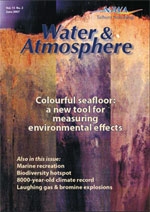PDF of this article (56 KB)

One of NIWA’s aims with this magazine is to contribute to science education in New Zealand. To this end we distribute Water & Atmosphere without charge to New Zealand high schools. Articles are assigned ‘Curriculum Connections’ to indicate which of the NZ NCEA Achievement or Unit Standards they can complement as a classroom resource. These links are assigned by Royal Society of New Zealand Teacher Fellows who are working during the year with NIWA scientists.
The magazine and the Curriculum Connections are also available online at www.niwa.co.nz/pubs/wa/ There you’ll find an archive of back issues beginning with September 2000 (vol. 8, no. 3). All online articles include a pdf of the printed version and the articles are indexed via the website’s search engine. The Curriculum Connections are compiled at www.niwa.co.nz/pubs/wa/resources/
Curriculum connections for this issue
| Pages | Article | Relevant NCEA Achievement Standards (AS) and Unit Standards (US) | Brief summary |
|---|---|---|---|
| 10–11 | Nitrous oxide: the serious side of laughing gas | Geography Level 1 AS90207, Level 2 AS90336 Science Level 2 US6352, AS90771, Level 3 US6355 | Rising levels of N2O are linked with the development of agriculture; itvs a major component of NZ’s greenhouse gas profile. |
| 12–13 | Bromine exposions and Antarctic ozone | Science Level 1 US6349 Technology Level 1 AS90051 | A new instrument package can measure rapid release of bromine in situ on the Antarctic sea ice. |
| 14–15 | A gift from the sea: managing kaimoana resources | Biology Level 1 US6299, Level 2 US6319, AS90769 Environmental Tourism Māori Level 3 US17788 Geography Level 1 AS90207, Level 2 AS90336, Level 3 US5097 Science Level 2 US6352, Level 3 US6355, US8153 | NIWA scientists are working with the Rongomaiwahine Iwi Trust to describe and monitor the stocks that support customary fishing in the Mahia Peninsula. |
| 16–17 | When the rivers run dry: invertebrate communities in intermittent streams | Biology Level 2 AS90461 | Aquatic insects and other invertebrates have a variety of strategies to cope with a habitat that changes radically. |
| 18–19 | Marine recreation and coastal ecosystems | Biology Level 2 AS90769 Environmental Tourism Māori Level 3 US17788 Geography Level 1 AS90207, Level 3 US5097 | Study of coastal use and the environmental effects focuses on ecotourism at Poor Knights Islands and snapper fishing in Hauraki Gulf. |
| 20–21 | Seaweed secrets reveal a biodiversity hotspot | Biology Level 2 AS90463 | DNZ research on a common group of seaweeds uncovers a hidden identity. |
| 22–23 | Colourful seafloor | Chemistry Level 1 AS90170, Level 2 US8947, Level 3 US6340 Science Level 1 US6349 Technology Level 1 AS90051 | A new way to study sediment colour helps scientists investigate change in coastal environments. |
| 24–25 | Eight thousand years of storms and droughts | Earth Science Level 2 US6362 Science Level 1 US6349 Weather Level 2 US20160 | Sediment cores from Lake Tutira in Hawke’s Bay hold a record of climate going back millenia. |
